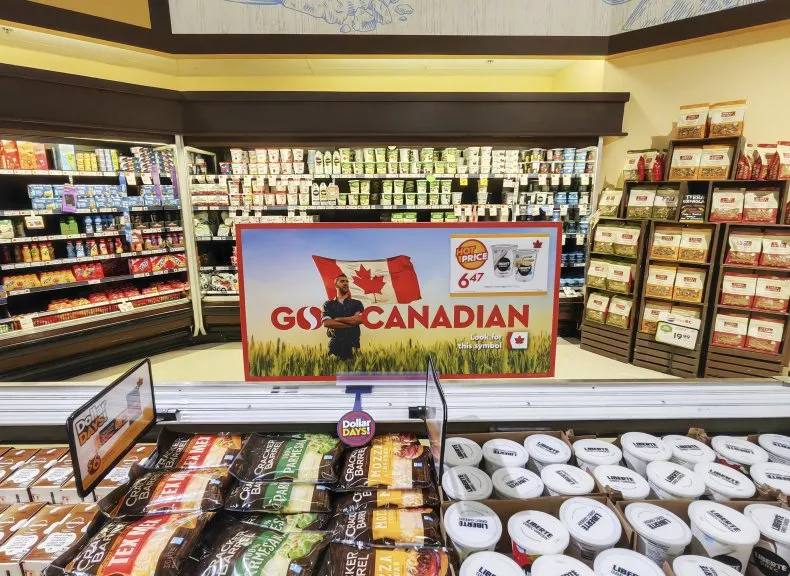Market Access & Promotion
Rice is one of the world’s most widely consumed grains and the primary dietary staple for more than half the world’s population. American rice farmers grow 9 million tons of rice each year, just more than half of which is exported to more than 120 countries.
The U.S. Department of Agriculture's Market Access Program (MAP), Foreign Market Development (FMD) Program, and Agricultural Trade Promotion Program (ATP) help the rice industry open foreign markets and promote our products abroad, with a proven track record of success in more than 30 overseas markets. Learn more about our international market promotions below.
International Promotions
Recent News
 'Made in Canada' displays in a Toronto grocery store encourage shoppers to buy local
'Made in Canada' displays in a Toronto grocery store encourage shoppers to buy local
Apr 24, 2025
TORONTO, CANADA – Call it the Revenge of the Freedom Fries. Remember in 2003 when France openly opposed the U.S. invasion of Iraq and there was a populist movement in the states to rename “French fries” as “Freedom fries”? Congress went further in their cafeterias, also changing the name of French Toast and French Bread. The anti-France sentiment was fairly short-lived, and by a margin of 2:1 public opinion labeled the movement “silly,” rather than “patriotic.”
However, the latest cross-border food fight the U.S. has gotten into, may have longer legs, as escalating trade tensions and threats to Canadian sovereignty prompted swift responses from the Canadian government and also rapidly altered Canadian consumers’ attitudes and behaviors towards the U.S. and its products. USA Rice Canada has been forced to make strategic adjustments, including turning off comments on social media posts.
According to recent data, 70 percent of Canadians have reduced their purchases of American products in stores, while 74 percent have increased their purchases of Canadian-made goods. Groceries are by far the most common substitute. According to the Angus Reid Institute, for the four in five Canadians who plan to buy more Canadian-made products, the grocery store is ground zero for this shift. Nearly all (98 percent) say they intend to purchase more Canadian groceries.
To assist consumers in identifying Canadian products, developers have already introduced apps like O SCANada and Maple Scan. These AI-enabled tools allow users to scan barcodes and determine a product's origin, making it easier to support local businesses.
While rice is not grown in Canada and there is no locally grown option, some consumers are choosing products that are not from the U.S. where and when possible, creating additional opportunities for Thai and Indian rices that are already popular here.
Canadian retailers are adjusting their strategies to align with changing consumer preferences. There's a notable emphasis on sourcing and promoting Canadian-made products to cater to the "Buy Canadian" sentiment in grocery stores. In response to the growing demand for Canadian products, retailers are prominently labeling and displaying local goods. For example, many stores have added maple leaf "Made in Canada" markers in aisles and are suggesting Canadian alternatives to U.S. brands on social media.
The decision of several provincial governments to remove U.S.-made alcohol from store shelves and cease future imports made headlines recently. The Liquor Control Board of Ontario has stopped selling more than 3,600 U.S. products, accounting for nearly $1 billion in annual sales, and has removed these items from its wholesale catalog to prevent restocking by restaurants and retailers.
This shift is not limited to alcohol. Retailers across Canada are reevaluating their supply chains, with many canceling or substituting orders for U.S. products in favor of Canadian (or other) alternatives. This strategic pivot aims to mitigate potential supply disruptions and align with consumer demand for non-U.S. goods.
One U.S. rice company said they were anticipating as much as a 30 percent drop in sales because of anti-U.S. sentiment and that they are losing shelf space even at U.S.-based retailers in Canada such as at Whole Foods and Walmart.
In response, U.S. rice marketing efforts in Canada in 2025 will focus on the attributes of rice that have attracted customers for years and remain unchanged, namely the grain’s nutritional value, versatility, accessibility, and sustainability commitments.
“We are evaluating media partnerships, influencer collaborations, and sampling campaigns and will proceed with creators who are aligned with USA Rice messaging to kick start our 2025 promotional activities,” said Asiha Grigsby, USA Rice senior director of international promotion for the Western Hemisphere. “We are using paid media and direct meetings to demonstrate to the trade and retail sector that we are dedicated to serving their market, but we recognize that at the moment, consumers have indicated a willingness to go without U.S. products or to pay more for alternatives, so we’re moving carefully.”
In addition to issues with consumer sentiment around U.S. products, in response to the Trump Administration’s 25 percent tariffs on Canadian steel and aluminum products and other non USMCA-compliant products imported into the U.S., Canada is retaliating against a spate of U.S. products, including a 25 percent tariff on U.S. rice.
“We are working closely with the U.S. government to resolve issues with Canada that led to the retaliation against U.S. rice,” said Karah Janevicius, USA Rice director of international trade policy. “Many Canadian companies rely on U.S. rice whether it's for foodservice, retail, or for further processing into pet food or alcohol, and it’s unfair that agricultural products like rice are caught in the crosshairs of this unrelated trade friction.”
Canada was the United States’ fifth largest market by value in 2024, at $175 million.